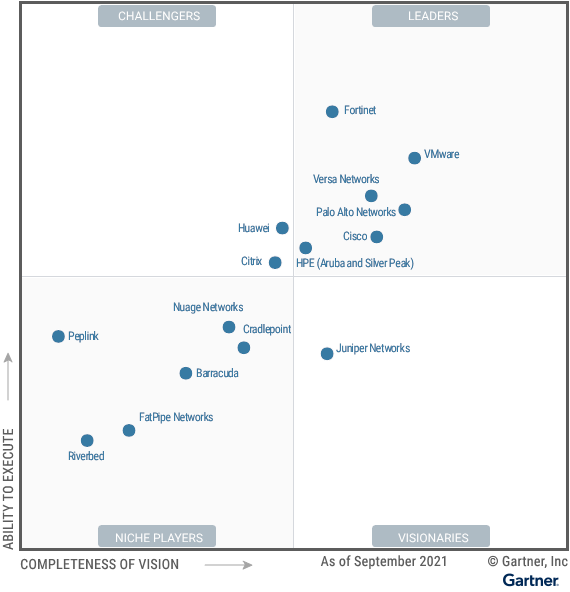Fortinet, VMware, Palo Alto, Versa Lead Packed Gartner WAN Edge Magic QuadrantFortinet, VMware, Palo Alto, Versa Lead Packed Gartner WAN Edge Magic Quadrant
According to Gartner, more and more enterprise customers want to rely on only public internet for their connectivity.

Fortinet, VMware and a few other companies are pushing each other for the lead in the latest Gartner Magic Quadrant for WAN edge infrastructure.
The same six companies occupy Gartner’s “Leaders” quadrant from 2020 to 2021: Fortinet, VMware, Versa Networks, Palo Alto Networks, Cisco and HPE. The race has tightened since 2019, when only VMware and Silver Peak (since acquired by HPE/Aruba) resided among the leaders.

Source: 2021 Gartner WAN Edge Infrastructure Magic Quadrant
The “Visionaries” quadrant contains only Juniper Networks. Last year it included Juniper and HPE Aruba, but HPE moved into the leader quadrant following its integration of Silver Peak. Citrix and Huawei continue to populate the “Challengers” quadrant.
Teldat represented the only true departure from the quadrant, having “failed to meet the inclusion criteria.” Gartner requires that vendors offer publicly available, 24/7-supported enterprise WAN edge networking hardware or software. Gartner counts SD-WAN and traditional branch routers as WAN edge infrastructure.
Customer Count
Gartner listed its estimations of how many WAN edge or SD-WAN customers each vendor possesses:
Cisco: 40,000 WAN edge customers
Fortinet: 34,000 WAN edge customers (and more than 10,000 SD-WAN customers)
Huawei: 20,000 WAN edge customers
Juniper Networks: 18,000 WAN edge customers
VMware: 14,000 SD-WAN customers
Peplink: 14,000 WAN edge customers
Barracuda: 12,000 WAN edge customers
Versa Networks: 12,000 WAN edge customers
Cradlepoint: 9,000 WAN edge customers
Riverbed” 3,000 SD-WAN customers
HPE Aruba 3,000 WAN edge customers
Nuage Networks: 2,500 enterprise WAN edge customers
FatPipe Networks: 2,000 WAN edge customers
Palo Alto Networks: 2,000 WAN edge customers
Citrix: 1,700 WAN edge customers
These numbers obviously should not be taken as one-to-one comparisons from one vendor to another. However, they give an interesting glimpse into the size of the market.
Trends
Gartner’s report reflects the movement of enterprise customers from private MPLS networks to public internet as their main source of connectivity. For example, Gartner predicted that 40% of enterprise locations will solely use internet WAN connectivity. Currently, 15% of them use only internet.
Gartner found that 40% of SD-WAN customers operate a secure access service edge (SASE) environment. Furthermore, Gartner forecasted that number to jump up to beyond 70% by 2024.
The study also predicted a rise in AI features connected to SD-WAN deployments. Gartner estimates that fewer than 5% of SD-WAN customers are using AI for “Day 2 operations.” However, it expects the percentage to rise to 40% by 2025.
Gartner forecasts the WAN edge market to grow at a compound annual growth rate of 2.6% from 2019 to 2025. On one hand, SD-WAN will grow at an 18% CAGR, while on the other, traditional branch office routers will decline 16.5%.
Dell’Oro Group earlier this month reported that first-half 2021 SD-WAN market bested first-half 2020 by 39%. Dell’Oro also said that the top six vendors hold 70% of market share.
About the Author
You May Also Like


